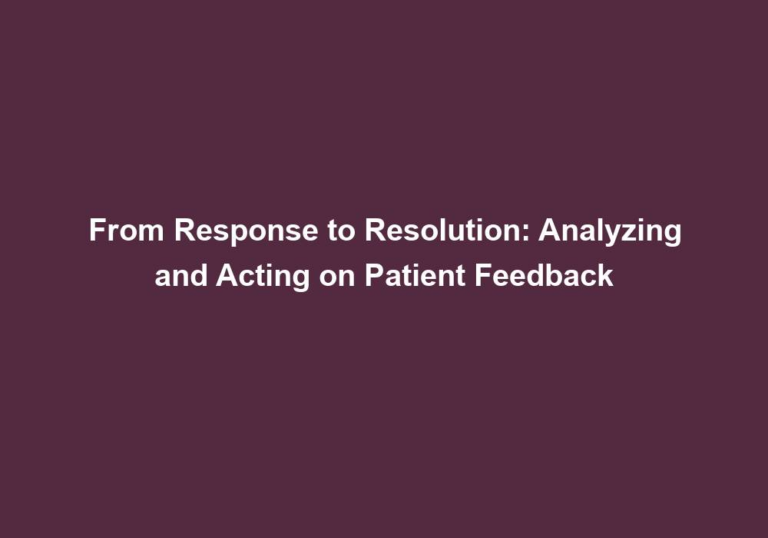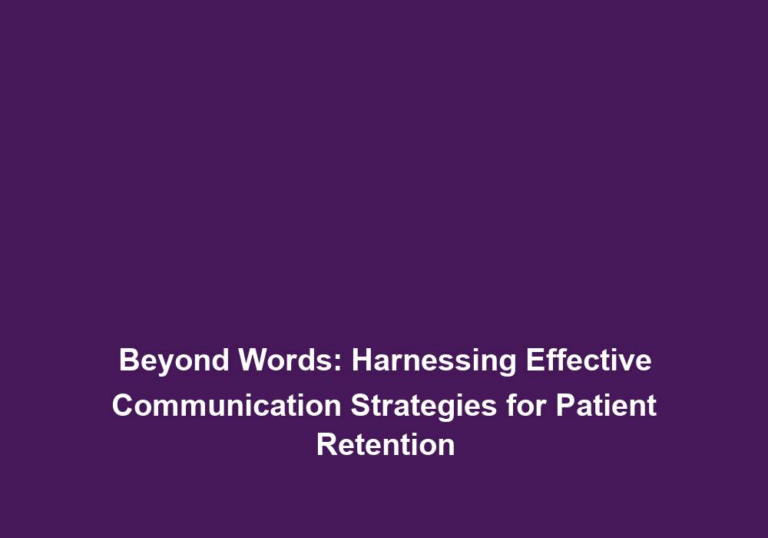Conversations that Count: Establishing a Robust Feedback Loop with Patients
In today’s rapidly evolving healthcare landscape, it has become increasingly important for healthcare providers to prioritize patient feedback and actively engage in meaningful conversations with their patients. By establishing a robust feedback loop, healthcare providers can gain valuable insights, improve the quality of care, and build stronger relationships with their patients. In this article, we will explore the significance of conversations that count and provide actionable tips for healthcare providers to enhance their feedback loop with patients.
The Power of Patient Feedback
Patient feedback is a powerful tool that can drive continuous improvement in healthcare organizations. It provides valuable insights into the patient experience, enabling healthcare providers to identify areas of strength and areas that require improvement. By actively seeking and incorporating patient feedback, healthcare providers can enhance the quality of care, streamline processes, and address any gaps in service delivery.
Not only does patient feedback help healthcare providers improve their services, but it also fosters patient satisfaction and loyalty. When patients feel that their opinions are valued and their concerns are being addressed, they are more likely to trust and continue seeking care from the same provider. This, in turn, can result in increased patient retention rates and positive word-of-mouth referrals.
Benefits of Patient Feedback:
- Drives continuous improvement by identifying areas of strength and improvement
- Enhances the quality of care by addressing gaps in service delivery
- Streamlines processes for better efficiency
- Fosters patient satisfaction and loyalty
- Increases patient retention rates and positive word-of-mouth referrals
Establishing a Robust Feedback Loop
To establish a robust feedback loop with patients, healthcare providers need to implement a systematic approach that ensures consistent and meaningful conversations. Here are some key steps to consider:
1. Active Listening:
Effective communication starts with active listening. Healthcare providers should actively listen to their patients, demonstrating empathy and understanding. This involves giving patients ample time to express their concerns, asking open-ended questions, and clarifying any uncertainties. By creating a safe and supportive environment, patients will feel more comfortable sharing their feedback.
- Give patients ample time to express their concerns
- Ask open-ended questions to encourage detailed responses
- Demonstrate empathy and understanding
- Clarify any uncertainties to ensure accurate feedback
2. Multiple Feedback Channels:
To capture a diverse range of patient perspectives, healthcare providers should offer multiple feedback channels. This can include in-person surveys, online feedback forms, email surveys, or even phone calls. By providing various options, healthcare providers can accommodate different patient preferences and ensure a higher response rate.
- Offer in-person surveys for patients who prefer face-to-face interactions
- Provide online feedback forms for convenient and accessible feedback
- Use email surveys to reach a wider audience
- Utilize phone calls for patients who may prefer verbal communication
3. Anonymous Feedback Option:
Some patients may hesitate to provide honest feedback due to fear of repercussions or discomfort in expressing their concerns openly. To overcome this barrier, healthcare providers should offer an anonymous feedback option. By allowing patients to provide feedback anonymously, providers can encourage more candid responses and uncover valuable insights that may otherwise go unreported.
- Offer an anonymous feedback option to ensure confidentiality
- Encourage patients to provide honest feedback without fear of repercussions
- Use anonymous feedback to uncover valuable insights and address sensitive issues
4. Timely Response:
In order to demonstrate their commitment to patient feedback, healthcare providers should prioritize timely responses. Acknowledging feedback promptly and addressing any concerns in a timely manner shows patients that their input is valued and taken seriously. This helps build trust and fosters a positive patient experience.
- Respond to patient feedback promptly and acknowledge their concerns
- Address any issues or concerns raised in a timely manner
- Show patients that their input is valued and taken seriously
- Build trust and foster a positive patient experience
5. Continuous Improvement:
The feedback loop should not end with a response. Healthcare providers should use patient feedback to drive continuous improvement efforts. This can involve analyzing feedback trends, identifying common issues, and implementing proactive measures to address them. Regularly reviewing and updating processes based on patient feedback ensures a patient-centered approach to care delivery.
- Analyze feedback trends to identify areas for improvement
- Address common issues raised by multiple patients
- Implement proactive measures to prevent recurring problems
- Regularly review and update processes based on patient feedback
Benefits of a Strong Feedback Loop
A strong feedback loop with patients offers several benefits for healthcare providers. Let’s explore some of the key advantages:
1. Improved Patient Satisfaction:
By actively engaging in conversations that count, healthcare providers can enhance patient satisfaction levels. When patients feel heard and respected, their overall satisfaction with the healthcare experience increases. This can lead to better patient outcomes and improved patient-provider relationships.
- Actively engaging in conversations improves patient satisfaction
- Patients feel heard and respected, leading to increased satisfaction
- Improved patient satisfaction leads to better patient outcomes
- Enhanced patient-provider relationships
2. Enhanced Quality of Care:
Patient feedback serves as a valuable resource for healthcare providers to identify areas of improvement and implement changes that enhance the quality of care. By addressing patient concerns and incorporating their suggestions, providers can optimize their services and ensure better patient outcomes.
- Patient feedback helps identify areas for improvement in care
- Implementing changes based on feedback enhances the quality of care
- Addressing patient concerns leads to better patient outcomes
- Incorporating patient suggestions optimizes healthcare services
3. Increased Patient Loyalty:
Patients who feel that their opinions matter are more likely to remain loyal to their healthcare providers. A robust feedback loop promotes patient loyalty by demonstrating a commitment to patient-centered care and continuous improvement. This can result in higher patient retention rates and increased referrals.
- Patients who feel their opinions matter are more likely to stay loyal
- A robust feedback loop demonstrates a commitment to patient-centered care
- Patient loyalty leads to higher retention rates and increased referrals
- Continuous improvement efforts attract and retain patients
4. Competitive Advantage:
In today’s competitive healthcare landscape, patient feedback can provide a significant competitive advantage. Organizations that actively seek and act upon patient feedback are perceived as more patient-centric and responsive to patient needs. This can attract new patients and differentiate healthcare providers from their competitors.
- Actively seeking and acting upon patient feedback sets organizations apart
- Patient-centric approach attracts new patients
- Differentiates healthcare providers from competitors
- Provides a significant competitive advantage
Conclusion
Establishing a robust feedback loop with patients is crucial for healthcare providers aiming to deliver patient-centered care and drive continuous improvement. By actively listening, offering multiple feedback channels, prioritizing timely responses, and continuously improving based on patient feedback, healthcare providers can enhance patient satisfaction, improve the quality of care, and gain a competitive edge. Embracing conversations that count will not only benefit patients but also contribute to the overall success of healthcare organizations.







